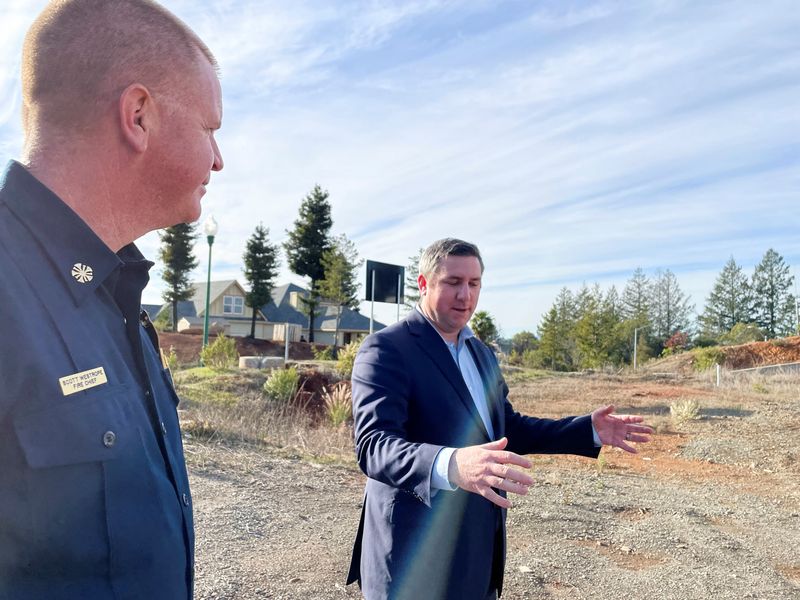By Sharon Bernstein
SANTA ROSA, Calif. (Reuters) - Five years after wildfire ravaged the California wine country city of Santa Rosa, only mud and a concrete pad remain atop a hill where a fire station once sat.
Fire Chief Scott Westrope, who lost his own home in the fire, said a priority was rebuilding Fire Station 5, which burned to the ground in the inferno that wiped out more than 5,600 structures and killed 22 people.
Building at the bottom of a hill would keep the station from experiencing the worst fires, which tend to run uphill. But Mayor Chris Rogers (NYSE:ROG) says the Federal Emergency Management Agency (FEMA) denied funding in part due to rules designed to protect infrastructure harmed in storms from flood damage, saying the proposed new location was in a flood zone.
As climate change reshapes the U.S. West, bringing warmer, drier weather that makes wildfires hotter, larger and more deadly, those in the path of potential fires say the fate of Fire Station 5 shows FEMA needs to develop more sophisticated processes for responding to them.
Devastating fires in Santa Rosa and communities elsewhere in California led survivors to press for changes in the way the agency handles wildfires. This month, federal lawmakers approved a bill updating an emergency response system critics say has been more suited to natural disasters other than fire.
"FEMA's expertise over the years has gotten good at anticipating and responding to hurricanes, floods and tornadoes," said U.S. Sen. Alex Padilla, a California Democrat. "Wildfire, not so much."
In a rare instance of bipartisanship, the bill sponsored by Padilla passed unanimously in both houses of Congress, with a final Senate vote earlier this month. President Joe Biden is expected to sign it.
The aim is to make sure the agency has processes to recognize the needs of communities across the country, in Republican and Democratic areas, impacted by wildfire. FEMA does not even always identify wildland fires as major disasters, Padilla said.
FEMA would not comment for this story, instead pointing to a statement in June by its Administrator Deanne Criswell acknowledging that climate change has fueled ever-larger and more frequent fires, and saying "we simply cannot shy away from the work required to mitigate future risk."
Padilla's office said the agency provided technical assistance in the development of his bill.
FEMA has been on the ground, providing temporary housing and counseling to survivors of wildfire in recent years, gaining expertise with experience as fires become more frequent.
In Paradise, California, where 19,000 structures were destroyed and 85 people killed in a 2018 wildfire, FEMA worked with residents to improve the agency's understanding of fire-specific needs such as the removal of hazardous trees, said the city’s Recovery and Economic Development Director Colette Curtis.
But FEMA procedures were generally not developed with the rugged terrain of fire country in mind, she said.
For example, the agency typically helps to set up a shelter, but given the vast distances and difficult roads in mountain areas, not to mention the fact that fire zones can be dangerous to enter for days or weeks, it was difficult for FEMA to find a site after Paradise, and hard for local people to reach it.
"There was a sense at FEMA that their systems could be used for all disasters, but that's not necessarily the case," Curtis said.
The Padilla bill would allow the agency to reimburse state and local agencies who put firefighting resources in place in advance of a fire earlier than they do now.
It would also require FEMA to develop a plan for recognizing that melted roads and infrastructure can be part of wildfire damage, and direct the agency to develop a protocol for responding to wildfire in disadvantaged communities.
Poor communities are particularly at risk of being denied funding for wildfire repairs, in part because the low value of homes makes it harder to meet minimum levels for financial damages set by a complicated formula. Such levels are easier to reach in cases of damage from widespread flooding or hurricanes, said Bryan Schenone, Emergency Operations Director in Siskiyou County, near the Oregon border.
In September, a wildfire burned all but a few houses to the ground in Lincoln Heights, a mostly poor, historically African-American community in the city of Weed in Siskiyou County. Requests for federal funding to help rebuild and pay other expenses for those displaced have stalled.
"We lost two towns this year in the McKinney Fire, and then we lost Lincoln Heights in Weed," Schenone said. "And both of those combined did not meet the threshold to consider it a disaster at the scale that would be required."
California expects to be turned down for its request for a major disaster declaration for Lincoln Heights and other communities damaged by wildfire last summer, said Brian Ferguson, spokesperson for the state Department of Emergency Operations.
In Santa Rosa, a midsized city about 55 miles north of San Francisco, the Tubbs Fire in 2017 raced through established suburban areas, jumping six lanes of highway, destroying homes.

It melted roads and left partially burned trees that posed a hazard if they fell – damage that FEMA was not set up to help repair, Mayor Rogers said.
The city has identified and purchased a new station site. But without help from FEMA, it has taken a while to put together rebuilding resources, Rogers said. The city hopes to break ground in the coming year.